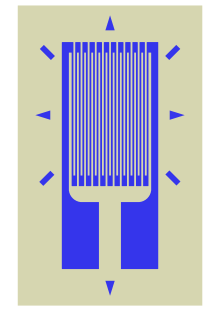Typical foil strain gauge. The gauge is far more sensitive to strain in the vertical direction than in the horizontal direction. The markings outside the active area help to align the gauge during installation.
A strain gauge is a device used to measure the strain of an object. Invented by Edward E. Simmons and Arthur C. Ruge in 1938, the most common type of strain gauge consists of an insulating flexible backing which supports a metallic foil pattern.
The gauge is attached to the object by a suitable adhesive, such as cyanoacrylate. As the object is deformed, the foil is deformed, causing its electrical resistance to change. This resistance change, usually measured using a Wheatstone bridge, is related to the strain by the quantity known as the gauge factor.
Physical operation

A strain gauge takes advantage of the physical property of electrical conductance and its dependence on not merely the electrical conductivity of a conductor, which is a property of its material, but also the conductor’s geometry. When an electrical conductor is stretched within the limits of its elasticity such that it does not break or permanently deform, it will become narrower and longer, changes that increase its electrical resistance end-to-end.
Conversely, when a conductor is compressed such that it does not buckle, it will broaden and shorten, changes that decrease its electrical resistance end-to-end. From the measured electrical resistance of the strain gauge, the amount of applied stress may be inferred.
A typical strain gauge arranges a long, thin conductive strip in a zig-zag pattern of parallel lines such that a small amount of stress in the direction of the orientation of the parallel lines results in a multiplicatively larger strain over the effective length of the conductor—and hence a multiplicatively larger change in resistance—than would be observed with a single straight-line conductive wire. Strain gauges measure only local deformations and can be manufactured small enough to allow a “finite element” like analysis of the stresses to which the specimen is subject. This can be positively used in fatigue studies of materials.